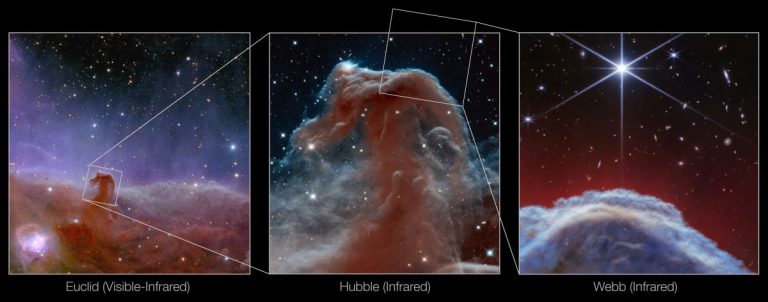Exceptionally Detailed Image of the Horsehead Nebula Captured by Webb
Key Takeaway
The James Webb Space Telescope has captured the sharpest and most detailed infrared image of the iconic Horsehead Nebula to date, revealing its complexity and intricate structures with unprecedented spatial resolution.
Summary
- The James Webb Space Telescope (JWST) has captured the sharpest infrared images ever taken of the Horsehead Nebula, a distinctive and iconic celestial object.
- The observations show a part of the Horsehead Nebula in an entirely new light, capturing its complexity with unparalleled spatial resolution.
- The image showcases JWST’s superior capabilities, as it even reveals background galaxies behind the nebula.
- The Horsehead Nebula, located about 1300 light-years away in the Orion constellation, is part of the larger Orion Molecular Cloud Complex.
- The nebula is a result of stellar erosion, formed by a collapsing cloud of material and illuminated by a nearby hot star called Sigma Orionis.
- The image also includes a comparison with previous observations of the Horsehead Nebula by the Euclid telescope (captured in November 2023) and the Hubble Space Telescope (captured in 2013).
- The Euclid image, taken with its wide-angle, 600-megapixel camera, showcases the telescope’s ability to gather highly detailed images quickly.
- The Hubble image, released for its 23rd anniversary, reveals structures hidden by dust, showcasing its renowned capabilities.
- While the Horsehead Nebula will eventually be eroded away in about 5 million years, powerful upcoming telescopes like the Giant Magellan Telescope and the European Extremely Large Telescope are expected to capture even more detailed images of this iconic celestial object.

A Breathtaking New View of the Iconic Horsehead Nebula
The James Webb Space Telescope (JWST) has captured the clearest and most detailed infrared image of the Horsehead Nebula so far. This famous nebula is 1300 light-years away in the Orion constellation. It has always interested astronomers and stargazers. The recent images from JWST show its details more clearly than ever before.
The JWST has taken new pictures of the Horsehead Nebula. These pictures show the nebula in great detail like never before. They highlight the JWST’s powerful ability to capture images. The pictures also show galaxies behind the nebula. This adds more detail to the amazing view of space.
This famous nebula is part of the larger Orion Molecular Cloud Complex. It was created by a cloud of material that collapsed. A nearby hot star, Sigma Orionis, lights it up. The JWST captures its complex structures and details. These give us a look at the dynamic processes that form such celestial wonders.
To fully appreciate the extraordinary nature of the JWST’s observations, the image also includes a comparison with previous observations of the Horsehead Nebula by the Euclid telescope (captured in November 2023) and the Hubble Space Telescope (captured in 2013).
The Euclid image, taken with its wide-angle, 600-megapixel camera, showcases the telescope’s ability to gather highly detailed images quickly. Meanwhile, the Hubble image, released for its 23rd anniversary, reveals structures hidden by dust, showcasing its renowned capabilities.

While these previous observations were groundbreaking in their own right, the JWST’s image takes our understanding of the Horsehead Nebula to new heights, revealing intricate details and structures that were previously invisible.
The Horsehead Nebula will disappear in about 5 million years. However, the future of exploring nebulae is very bright. This is because of new powerful telescopes being developed. These include the Giant Magellan Telescope and the European Extremely Large Telescope. They will be able to take more detailed pictures of the Horsehead Nebula. As a result, we will learn even more about the amazing space objects around us.

